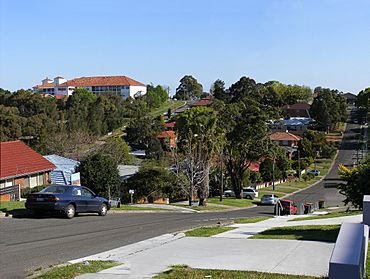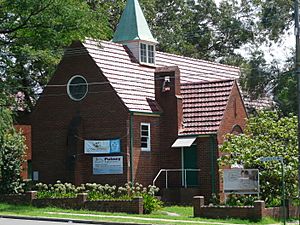Putney, New South Wales facts for kids
Quick facts for kids PutneySydney, New South Wales |
|||||||||||||||
|---|---|---|---|---|---|---|---|---|---|---|---|---|---|---|---|

Typical Putney streetscape
|
|||||||||||||||
| Population | 4,097 (2021 census) | ||||||||||||||
| Postcode(s) | 2112 | ||||||||||||||
| Elevation | 29 m (95 ft) | ||||||||||||||
| Location | 14 km (9 mi) WNW of Sydney CBD | ||||||||||||||
| LGA(s) | City of Ryde | ||||||||||||||
| State electorate(s) | Lane Cove | ||||||||||||||
| Federal Division(s) | Bennelong | ||||||||||||||
|
|||||||||||||||
Putney is a suburb in Northern Sydney, New South Wales, Australia. It is about 14 kilometers (9 miles) north-west of the Sydney central business district (CBD). Putney sits on the northern bank of the Parramatta River. The local government area for Putney is the City of Ryde.
Contents
History of Putney
Long ago, the Walumedegal clan of Aboriginal people lived in the Putney area. You can still find signs of them around Morrisons Bay and Glades Bay. These include rock shelters, rock carvings, art sites, and places where they sharpened their axes.
Early European Settlement
The area of Putney and Ryde was first called Eastern Farms by British settlers. Later, it was known as Kissing Point. This was one of the first places where British people settled in the colony.
One of the earliest settlers was a brewer named James Squire. He moved here in 1792 and started his brewery, the Malt Shovel, near what is now Kissing Point.
The eastern part of Putney was given as land to Nicholas Bayly in 1799. This land was later sold to Eugene Delange. He divided the land into smaller pieces and called it the Village of Eugenie.
How Putney Got Its Name
The name was later changed to Putney. It was named after a place called Putney on the River Thames in London, England. The Parramatta River was often called the 'Thames of the Antipodes' (meaning the opposite side of the world). Other nearby suburbs like Greenwich, Woolwich, and Henley were also named after places along the Thames.
Rowing on the Parramatta River
Putney was a great spot to watch World Championship rowing races. These races took place from the 1880s to the 1930s. The first big rowing event happened in 1847 at Kissing Point. People in Sydney loved rowing, and there were big prizes for local and national champions.
By the 1880s, thousands of people gathered by the river to watch world championship sculling races. Sculling is a type of rowing with two oars. The race course went between Kissing Point and Uhr's Point. People were so excited about rowing that they called it "water on the brain."
World Championship races were held here, and people in Britain and America eagerly waited for the results. Both men and women talked about the river conditions, race times, and boat details. Many champions trained at Ryde. Famous Australian poet Banjo Paterson wrote about how many rowers practiced on the river every morning.
Local, national, and international races took place on the Parramatta River. Universities and GPS schools also held their yearly rowing events here from 1893 to 1935.
Mortlake Ferry
Before 1896, a small boat service, called a punt, crossed the river between Putney Point and Mortlake Point. People had to push this punt by hand. In 1928, a cable ferry was opened. It was officially named the Mortlake Ferry. This ferry is the last working punt in the Sydney area.
World War II Efforts
During World War II in 1943, a company called Slazengers (Australia) Pty Ltd built a shipyard in Putney. This company made military equipment for the United States Army and the Australian Government. The Putney shipyard built scows (flat-bottomed boats) and landing craft for the war. Slazengers also made military huts, houses for workers, canteens, hospitals, small weapons, ammunition boxes, and gas masks.
Morrisons Bay and Tennyson Estate
Morrisons Bay is named after Archibald Morrison. He was a soldier who received a land grant of 55 acres in 1795. Captain William Raven, one of the colony's richest settlers, owned 100 acres between Glades Bay and Morrisons Bay. This land was divided into smaller plots in 1887.
The Tennyson Estate was named after Lord Alfred Tennyson. It was advertised as having the best views of the Championship rowing course. Two world champion rowers, Beach (1884) and Kemp (1887), have streets named after them in Putney. The eastern side of Morrisons Bay used to have a textile mill. The head of the bay is now a flat area that was once mangrove swamps. River baths were built here in 1918.
Transport in Putney
Putney has bus services provided by Busways. Route 507 travels between Gladesville and Meadowbank wharf. The Kissing Point ferry wharf is in Putney. From here, you can take a ferry to Circular Quay in about 40 minutes.
Meadowbank railway station is just outside Putney's north-western border.
Landmarks and Facilities
Putney has many useful facilities. These include a primary school, a post office, sports fields, and parks. There is also a shopping area and several restaurants.
Putney is home to St Chad's Anglican Church on Delange Road. This church was founded in 1912 and is important historically. It is named after St Chad of Mercia. He lived in the 7th century and was a bishop and leader of several monasteries.
Cleves Park is thought to be the burial place of Bennelong. He was a famous Aboriginal man who played an important role in early Sydney history. The park has a special plaque to remember him.
Images for kids
-
Home in Spanish Mission style, Douglas Street







